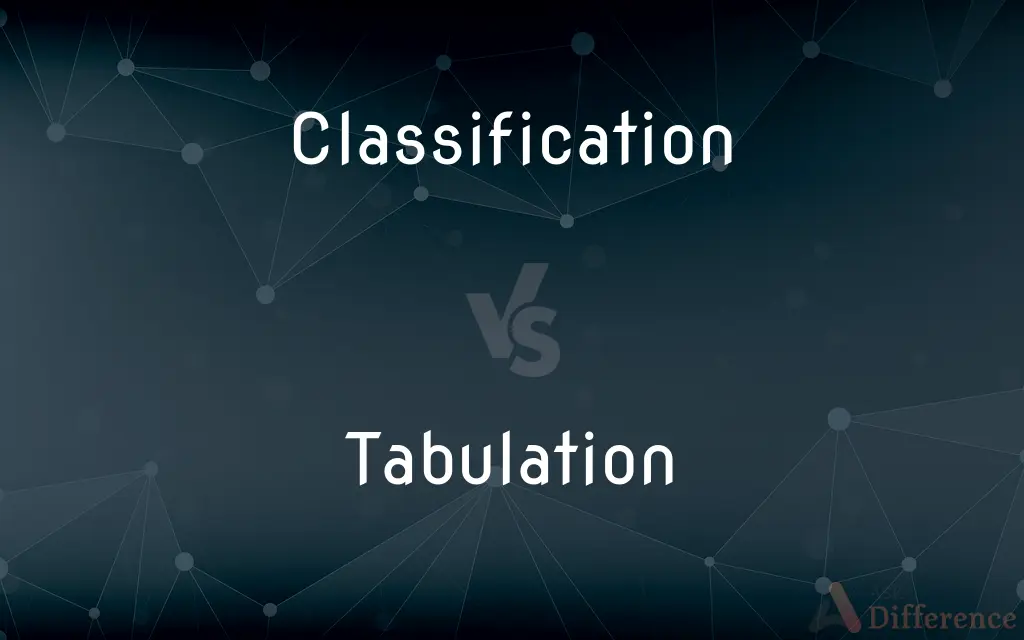Classification vs. Tabulation — What's the Difference?
By Tayyaba Rehman — Updated on September 20, 2023
Classification involves grouping data based on shared characteristics, while tabulation is arranging data in tables for better comprehension.

Difference Between Classification and Tabulation
Table of Contents
ADVERTISEMENT
Key Differences
Classification is the process of systematically grouping data or items based on their shared attributes or characteristics. The essence of classification lies in its ability to simplify and organize complex data sets. For instance, in biology, creatures are classified into different taxa based on shared features.
Tabulation, conversely, refers to the methodical arrangement of data into rows and columns in a table. This structured format makes complex data more digestible, offering clarity and facilitating comparisons. Financial reports, for example, use tabulation to present and compare monetary figures over different periods.
While both classification and tabulation are techniques to manage and present data, they serve distinct purposes. Classification primarily concerns itself with grouping and categorizing, laying the groundwork for analysis. Once classified, data can be further enhanced through tabulation, visually representing the classified information in an easily understandable manner.
It's crucial to understand that classification is usually a precursor to tabulation. Before data can be tabulated, it often needs to be classified to determine the most effective way to present it. However, it's possible to have classification without tabulation, but the reverse is less common.
Both classification and tabulation are foundational in research, statistics, and various academic and professional disciplines. They help in making sense of vast data sets and in drawing meaningful conclusions from them.
ADVERTISEMENT
Comparison Chart
Definition
Grouping data based on similarities
Arranging data in rows and columns
Purpose
Organize and categorize data
Represent data visually for clarity
Process
Grouping and categorizing
Structuring in table format
Outcome
Simplified and structured data
Easily digestible and comparable data
Usage
Often a precursor to tabulation
Usually follows classification
Compare with Definitions
Classification
Grouping items into predetermined categories.
The library's classification system helps locate books easily.
Tabulation
The act of organizing data in a table format.
The tabulation of survey results showed interesting trends.
Classification
Assigning items into specific classes or groups.
The meteorological department uses a classification for hurricanes based on their intensity.
Tabulation
Structured arrangement for better visualization.
The tabulation of votes took a few hours after the election.
Classification
The act of organizing data based on shared attributes.
The classification of animals is based on their taxonomy.
Tabulation
Formatting data for easy comparison and understanding.
The research study's tabulation made it easier to interpret findings.
Classification
Systematically arranging entities based on properties.
The periodic table is a classification of elements based on atomic number.
Tabulation
Representing information using rows and columns.
The annual report included a tabulation of yearly expenses.
Classification
Sorting based on certain criteria or standards.
His job involves the classification of mail by region.
Tabulation
Systematic display of classified data.
The census data required careful tabulation to represent the population distribution.
Classification
The action or process of classifying something
The classification of disease according to symptoms
Tabulation
To arrange in tabular form; condense and list.
Classification
The act, process, or result of classifying.
Tabulation
To cut or form with a plane surface.
Classification
A category or class.
Tabulation
Having a plane surface.
Classification
(Biology) The systematic grouping of organisms into categories on the basis of evolutionary or structural relationships between them; taxonomy.
Tabulation
The act or process of tabulating
Classification
The act of forming into a class or classes; a distribution into groups, as classes, orders, families, etc., according to some common relations or attributes.
Tabulation
A result of tabulating: a table, displaying data in compact form
Here is a tabulation of baseless claims made in the last month.
Classification
The act of forming into a class or classes; a distribution into groups, as classes, orders, families, etc., according to some common relations or affinities.
Tabulation
(computing) A printout
Classification
The act of distributing things into classes or categories of the same type
Tabulation
(biology) The pattern of plates on a dinoflagellate
Classification
A group of people or things arranged by class or category
Tabulation
The act of forming into a table or tables; as, the tabulation of statistics.
Classification
The basic cognitive process of arranging into classes or categories
Tabulation
Information set out in tabular form
Classification
Restriction imposed by the government on documents or weapons that are available only to certain authorized people
Tabulation
The act of putting into tabular form;
The tabulation of the results
Common Curiosities
Can you tabulate without classifying?
Typically, data is classified before tabulation, but it's not a strict requirement.
Why is tabulation important?
Tabulation makes data easy to understand, compare, and analyze.
Does classification always require predefined categories?
Not always; sometimes, categories emerge during the classification process.
Are classification and tabulation the same?
No, classification groups data based on similarities, while tabulation represents data in table format.
What's an example of classification in daily life?
Sorting laundry by color or fabric type is a form of classification.
Are tables the only form of tabulation?
While tables are common, tabulation can also involve other structured visual representations.
Is classification subjective?
Classification can be based on established criteria, but sometimes subjective judgment is involved.
Can a single set of data have multiple tabulations?
Yes, depending on the focus, data can be tabulated in various ways.
Do all research studies involve tabulation?
While many do, not all research studies require tabulation.
Is there software for classification and tabulation?
Yes, various software tools assist in data classification and tabulation, like Excel or SPSS.
Can classification change over time?
Yes, as understanding or criteria evolve, classification can be revised.
How detailed should classification be?
The level of detail in classification depends on the purpose and the data's complexity.
Is classification limited to quantitative data?
No, classification can be applied to both quantitative and qualitative data.
Can tabulation be used in presentations?
Absolutely, tabulation can effectively convey data in presentations.
Why is tabulation used in statistical analysis?
Tabulation simplifies data, making statistical analysis more straightforward.
Share Your Discovery

Previous Comparison
Get vs. Take
Next Comparison
Catalyst vs. InhibitorAuthor Spotlight
Written by
Tayyaba RehmanTayyaba Rehman is a distinguished writer, currently serving as a primary contributor to askdifference.com. As a researcher in semantics and etymology, Tayyaba's passion for the complexity of languages and their distinctions has found a perfect home on the platform. Tayyaba delves into the intricacies of language, distinguishing between commonly confused words and phrases, thereby providing clarity for readers worldwide.














































